Legislative Council of Quebec
The Legislative Council of Quebec (French; Conseil législatif du Québec) was the unelected upper house of the bicameral legislature in the Canadian province of Quebec from 1867 to 1968. The Legislative Assembly was the elected lower house.
Legislative Council of Quebec Conseil législatif du Québec | |
|---|---|
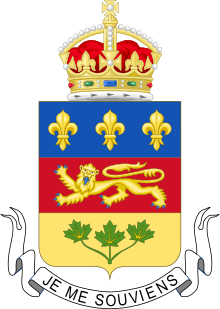 | |
| Type | |
| Type | of the Quebec Legislature |
Term limits | Life appointments |
| History | |
| Founded | July 1, 1867 |
| Disbanded | December 31, 1968 |
| Preceded by | Legislative Council of the Province of Canada |
| Succeeded by | none |
| Seats | 24 |
| Meeting place | |
 | |
| The Red Chamber, former chamber of the Legislative Council | |
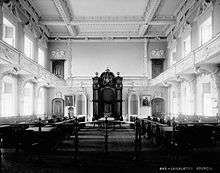
The Council was composed of 24 members, appointed by the Lieutenant Governor upon the recommendation of the Premier. Each councillor nominally represented a portion of the Province of Quebec called a division. The boundaries of these divisions were identical to the ones used for Canada East by the Legislative Council of the Province of Canada and were also identical to the boundaries still used today by the Senate of Canada for Quebec. The division boundaries were never changed to accommodate territorial expansions of Quebec in 1898 and 1912.
The Legislative Council was abolished in 1968 and the Legislative Assembly was renamed the National Assembly of Quebec. Since the abolition, Quebec has a unicameral legislature.
Powers of the Legislative Council
The Council had the right to introduce bills, except of a financial nature, and to amend, or veto bills passed by the Legislative Assembly. Its speaker, known in French as orateur, was by right a member of the Cabinet, and its members could serve as ministers or even premier. Two Quebec premiers, Charles-Eugène Boucher de Boucherville and John Jones Ross were members of the Legislative Council.
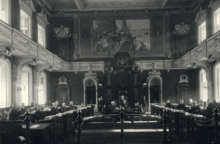
Appointment of Members of the Legislative Council
Members were originally appointed for life. In 1963, the rule was changed to force members to retire at age 75, but that did not apply to members who had already been appointed. In the event, the change remained entirely theoretical since the Council was abolished before it could be applied to anyone.
Abolition of the Legislative Council
Effective December 31, 1968 the Legislative Council was abolished, and the Legislative Assembly of Quebec was renamed the National Assembly.[1] As a consequence, Quebec now has a unicameral legislature. The establishment of the original system dates back to the Constitutional Act of 1791.
The Union Nationale government of Premier Jean-Jacques Bertrand passed the legislation, known as "Bill 90", to implement the change. Previous governments had made unsuccessful attempts to eliminate the upper chamber. In fact, the first attempt dated all the way back to Félix-Gabriel Marchand, in the late 19th century. Quebec was the last Canadian province to abolish its upper house.
When it was dissolved, it had 15 members of the Union Nationale and 9 Liberal Party members.
The Red Chamber
The large chamber that housed the Legislative Council is also known in French as le salon rouge (the red hall) and in English as "the Red Room" because of the predominance of the colour on the walls. It is now used for committee meetings and for important state functions that require a large, impressive hall, such as inductions into the National Order of Quebec.
Speakers of the Legislative Council of Quebec (1867–1968)
The Speaker of the Legislative Council (in French, the Orateur) was appointed by the government. Most Speakers sat in the Cabinet. The Speaker was the presiding officer of the Legislative Council, but could vote like other members. In the event of a tie, the Speaker did not have a casting vote. The motion simply failed.
| Portrait | Name | Appointment | Ending | Political party | |
|---|---|---|---|---|---|
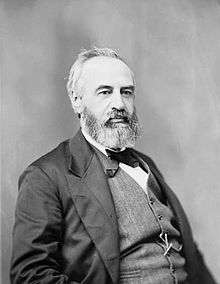 |
Charles-Eugène Boucher de Boucherville | July 15, 1867 | February 27, 1873 | Conservative | |
 |
John Jones Ross | February 27, 1873 | September 22, 1874 | Conservative | |
| Félix-Hyacinthe Lemaire | September 22, 1874 | January 27, 1876 | Conservative | ||
 |
John Jones Ross | January 22, 1876 | March 8, 1878 | Conservative | |
 |
Henry Starnes | March 8, 1878 | October 31, 1879 | Liberal | |
 |
John Jones Ross | October 31, 1879 | March 4, 1882 | Conservative | |
 |
Pierre Boucher de la Bruère | March 4, 1882 | April 23, 1889 | Conservative | |
 |
Henry Starnes | April 23, 1889 | March 17, 1892 | Liberal | |
 |
Pierre Boucher de la Bruère | March 17, 1892 | April 5, 1895 | Conservative | |
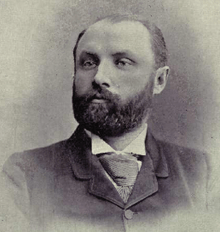 |
Thomas Chapais | April 5, 1895 | January 12, 1897 | Conservative | |
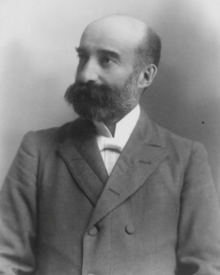 |
Vildebon-Winceslas Larue | January 12, 1897 | June 17, 1897 | Conservative | |
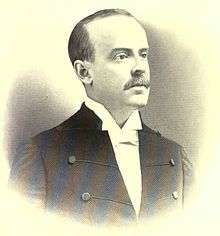 |
Horace Archambeault | June 17, 1897 | September 15, 1908 | Liberal | |
 |
Adélard Turgeon | February 2, 1909 | November 14, 1930 | Liberal | |
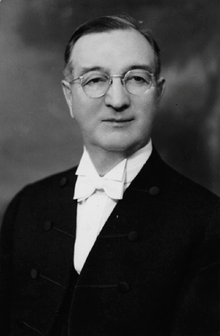 |
Jacob Nicol | November 25, 1930 | July 25, 1934 | Libéral | |
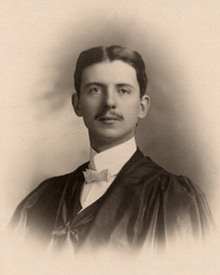 |
Hector Laferté | July 27, 1934 | October 2, 1936 | Liberal | |
 |
Alphonse Raymond | October 2, 1936 | January 17, 1940 | Union Nationale | |
 |
Hector Laferté | January 17, 1940 | December 31, 1944 | Libéral | |
 |
Alphonse Raymond | December 31, 1944 | February 1, 1950 | Union Nationale | |
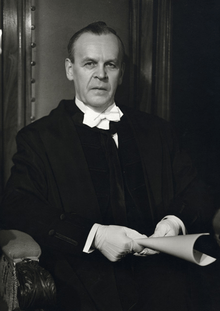 |
Jean-Louis Baribeau | February 1, 1950 | July 6, 1960 | Union Nationale | |
 |
Hector Laferté | July 6, 1960 | June 23, 1966 | Liberal | |
 |
Jean-Louis Baribeau | June 23, 1966 | December 31, 1968 | Union Nationale | |
Legislative Council divisions
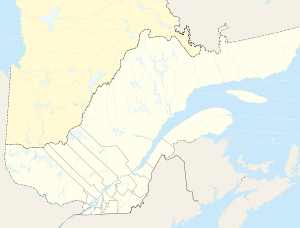
The twenty-four members of the Legislative Council were each appointed to represent a division of Quebec. The divisions were originally defined by statute for the Legislative Council of the Province of Canada in 1856, when elected members were included in the Legislative Council.[2] The statutory descriptions of the divisions were then incorporated into the Consolidated Statutes of Canada, 1859.[3] In 1867, the British North America Act, 1867 simply adopted the existing twenty-four divisions for the new Legislative Council of Quebec, although the new Council was appointed, rather than elected.[4]
Although the boundaries of Quebec were extended northwards twice, in 1898 and again in 1912, the boundaries of the Legislative Council divisions were never altered.
Alma
The Alma division was defined as: "The Parishes of Long Point, Pointe-aux-Trembles, Rivière des Prairies, Sault aux Récollets, in the county of Hochelaga, and that part of the Parish of Montreal which lies to the East of the prolongation of St. Denis Street; the County of Laval, that part of the City of Montreal which lies to the East of Bonsécours and St. Denis Streets, and their prolongation."
Bedford
The Bedford division was defined as: "The Counties of Missisquoi, Brome, and Shefford."
De la Durantaye
The De la Durantaye division was defined as "The remainder of the County of L'Islet, the countie[s] of Montmagny and Bellechasse and the Parishes of St. Joseph, St. Henri and Notre Dame de la Victoire, in the County of Lévi." (See the description of the Grandville division for the explanation of the "remainder of the County of L'Islet".)
De la Vallière
The De la Vallière division was defined as: "The Counties of Nicolet and Yamaska, the Townships of Wendover, Grantham, and the part of Upton which lies in the County of Drummond."
De Lanaudière
The De Lanaudière division was defined as "The remainder of the County of Maskinongé, the Counties of Berthier and Joliette, with the exception of the Parish of St. Paul, the Township of Kildare and its augmentation, and the Township of Cathcart". (See the description of the Shawinigan division for the explanation of the "remainder of the County of Maskingongé".)
De Lorimier
The De Lorimier division was defined as: "The Counties of St. John and Napierville; St. Jean Chrysostôme and Russeltown in the County of Chateauguay; Hemmingford in the County of Huntingdon."
De Salaberry
The De Salaberry division was defined as: "The remainder of the County of Chateauguay, the remainder of the County of Huntingdon, and the County of Beauharnois." (See the description of the De Lorimier division for the explanation of the parishes which were excluded from the De Salaberry division.)
Grandville
The Grandville division was defined as: "The Counties of Temiscouata and Kamouraska, the Parishes of St. Roch des Aulnets and St. Jean Port Joli, and the prolongation thereof in a straight line to the Province Line in the County of L'Islet."
Gulf
The Gulf division was defined as: "The Counties of Gaspé, Bonaventure and Rimouski."
Inkerman
The Inkerman division was defined as: "The Counties of Argenteuil, Ottawa and Pontiac."
Kennebec
The Kennebec division was defined as: "The Counties of Lotbinière, Mégantic and Arthabaska."
La Salle
The La Salle division was defined as: "The remainder of the County of Quebec, the County of Portneuf, and all that part of the Banlieue of Quebec which lies within the Parish of Notre Dame de Quebec." (See the description of The Laurentides division for the explanation of the "remainder of the County of Quebec".)
Lauzon
The Lauzon division was defined as: "The remainder of the County of Lévi, the Counties of Dorchester and Beauce." (See the description of the De la Durantaye division for the explanation of the "remainder of the County of L'Islet".)
Mille Isles
The Mille Isles division was defined as: "The Counties of Terrebonne and Two Mountains."
Montarville
The Montarville division was defined as: "The Counties of Verchères, Chambly and Laprairie."
Repentigny
The Repentigny division was defined as: "The Parish of St. Paul, the Township of Kildare and its augmentation, and the Township of Cathcart, in the County of Joliette, the Counties of L'Assomption and Montcalm".
Rigaud
The Rigaud division was defined as: "The remainder of the Parish of Montreal, and the Counties of Jacques Cartier, Vaudreuil and Solanges." (See the description of the Alma division for the explanation of the "remainder of the Parish of Montreal".)
Rougemont
The Rougemont division was defined as "The remainder of the County of St. Hyacinth, the Counties of Rouville and Iberville." (See the description of the Saurel division for the explanation of "the remainder of the County of St. Hyacinth".)
Saurel
The Saurel division was defined as "The Counties of Richelieu and Bagot, the Parishes of St. Denis, La Présentation, St. Barnabé, and St. Jude, in the County of St. Hyacinth."
Shawinigan
The Shawinigan division was defined as "The Counties of Champlain and St. Maurice, the Town of Three Rivers, the Parishes of River du Loup, St. Léon, St. Paulin, and the Township of Hunterstown and its augmentation, in the County of Maskinongé."
Stadacona
The Stadacona division was defined as "The remainder of the City and Banlieue of Quebec." (See the description of the La Salle division for the explanation of "remainder of the City...of Quebec".)
The Laurentides
The Laurentides division was defined as: "The Counties of Chicoutimi, Charlevoix, Saguenay and Montmorency, the Seigniory of Beauport, the Parish of Charlebourg, the Townships of Stoneham and Tewkesbury, in the County of Quebec."
Victoria
The Victoria division was defined as: "The remainder of the City of Montreal exclusive of the Parish." (See the description of the Alma division for the explanation of the "remainder of the City of Montreal".)
Wellington
The Wellington division was defined as: "The remainder of the County of Drummond, the County of Richmond, the Town of Sherbrooke, the Counties of Wolfe, Compton, and Stanstead." (See the description of the De la Vallière division for the explanation of the "remainder of the County of Drummond".)
Members of the Legislative Council
References
- "L'Assemblée législative devient l'Assemblée nationale: 31 décembre 1968". Révolution tranquille (in French). Government of Quebec. Archived from the original on 2012-05-21. Retrieved February 19, 2012.
- An Act to change the Constitution of the Legislative Council by rendering the same Elective, SProvCan 1856 (1856-57 Vict.), c. CXL, s. I and Schedule A.
- An Act respecting the Legislative Council, CSC 1859, c. 1, s. 1 and Schedule.
- British North America Act, 1867 (now the Constitution Act, 1867), s. 22 and s. 72